
Drawing of mature tree, saplings, foliage, and cones [Matt Strieby, 2019.11].

Frank Callahan with the Tannen Lakes Titan, one of the largest known trees, destroyed by fire in 2022 [C.J. Earle, 2009.06.26].
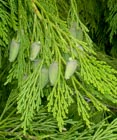
Foliage and immature cones on a tree in habitat, northwestern California [C.J. Earle, 2009.07.12].
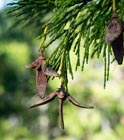
Foliage and old cone on a tree in south-central Oregon [C.J. Earle, 2019.06.09].
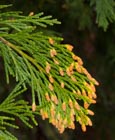
Pollen cones and foliage on a tree in the Siskiyou Mountains of Oregon [C.J. Earle, 2011.01.30].
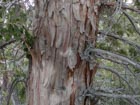
Bark on a 30 cm diameter tree, Mt. San Jacinto, California [C.J. Earle, 2002.03.06].
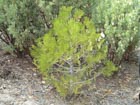
Sapling, Alandale Station, Mt. San Jacinto, CA [C.J. Earle, 2004.04.09].

Seedling, 5 cm tall [C.J. Earle, 2005.07.24].
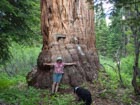
The Devils Canyon Colossus, largest known specimen [C.J. Earle, 2012.07.01].
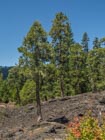
Near Santiam Pass, at one of the northernmost known stands, the trees grow on a young lava flow [C.J. Earle, 2016.07.03].

Conservation Status

Calocedrus decurrens
(Torrey) Florin 1956
Common names
Incense-cedar; white, bastard, or California post cedar (Peattie 1950), cedro incienso [Spanish] (Thieret 1993).
Taxonomic notes
Syn: Libocedrus decurrens Torrey 1853 (Thieret 1993).
Description
Resinous, aromatic tree 18-46(57) m tall and 90-150(360) cm dbh. Tapering, irregularly angled trunk and narrow, columnar crown, becoming open and irregular. Bark light or reddish-brown, thick, fibrous, deeply and irregularly furrowed into shreddy ridges. Twigs much-branched and flattish, with wedge-shaped joints longer than broad; composed of scalelike leaves. Leaves evergreen, shiny, opposite in 4 rows, 3-14 mm long, scalelike, including long-decurrent base, rounded abaxially, apex acute (often abruptly), usually mucronate, the side pair keeled, long-pointed, overlapping the next pair, extending down twig; aromatic when crushed. Pollen cones red-brown to light brown. Seed cones cones red-brown to golden brown, 14-25 mm long (including wings), oblong-ovate when closed, pendant at end of slender, leafy stalk, proximal scales often reflexed at cone maturity, median scales then widely spreading to recurved, distal scales erect. Seeds 4 or fewer in cone, paired with 2 unequal wings. 2n= 22 (Little 1980, Thieret 1993). See García Esteban et al. (2004) for a detailed characterization of the wood anatomy.
Although the big "cedars" (actually, species of Calocedrus, Chamaecyparis, Callitropsis, and Thuja) of western North America tend to look alike at first, the incense-cedar is easily distinguished by the fact that its foliage is held in flattened vertical sprays.
Distribution and Ecology
USA: W Oregon, Nevada (the Lake Tahoe area) and California; Mexico: Northern Baja California Norte; at elevations of 50-2010 m in the northern parts of its range, rising to 910-2960 in the south. The northern range limit is on the southern slopes of Mount Hood, while the southern limit is in the Sierra San Pedro Martír (Powers and Oliver 1990). See also Thompson et al. (1999).
Distribution data from USGS (1999).
Within its native range, the climate is characterized by dry summers, usually with less than 25 mm precipitation per month; annual temperature extremes are -34°C to 48°C. Annual precipitation, part of which is snow, varies from 380 to 2030 mm, with the driest conditions found near the species' northern limits in Oregon and northeast California. It grows on an exceptionally wide variety of soils, derived from silicate, serpentine, and carbonate parent materials, and textures ranging from coarse sand to clay (Powers and Oliver 1990). Hardy to Zone 7 (cold hardiness limit between -17.7°C and -12.2°C) (Bannister and Neuner 2001). Considering its superficial resemblance to the other large western cedars, Thuja plicata, Chamaecyparis lawsoniana and Callitropsis nootkatensis, it shows a surprising tolerance of hot, dry sites with poor soils, growing in settings more typical of Hesperocyparis or Juniperus, notwithstanding, the largest specimens tend to occur on sunny, well-watered sites such as riparian areas in canyons or near subalpine lakeshores.
Seldom found in pure stands, it is usually a subdominant or codominant component occurring in mixed forest with, in the northern part of its range, Chamaecyparis lawsoniana, Thuja plicata, Abies concolor var. lowiana, Abies grandis, Pinus jeffreyi, Pinus lambertiana, Pinus monticola, Pinus ponderosa, Pseudotsuga menziesii subsp. menziesii, Tsuga heterophylla, Quercus garryana, Quercus kelloggii, Lithocarpus densiflorus, Castanopsis chrysophylla, and Arbutus menziesii. In the central part, it grows with Sequoiadendron giganteum, Abies concolor var. lowiana, Abies magnifica, Pinus contorta subsp. murrayana, Pinus jeffreyi, Pinus lambertiana, Pinus ponderosa, Pseudotsuga menziesii subsp. menziesii, Quercus kelloggii, Lithocarpus densiflorus, Castanopsis chrysophylla, and Arbutus menziesii. In the southern part, common associates are Pinus coulteri, Pinus jeffreyi, Pinus ponderosa, Pinus lambertiana, Pseudotsuga macrocarpa, and Quercus kelloggii. Tree associates on ultramafic soils include Pinus attenuata, Pinus jeffreyi, Pinus lambertiana, Pinus monticola, and Pseudotsuga menziesii subsp. menziesii (Powers and Oliver 1990).
Calocedrus decurrens is tolerant of moderate intensity fire because of its thick bark (Little 1980).
Remarkable Specimens
The largest known specimen is the Devil's Canyon Colossus: dbh 378 cm, height 50.3 m, stem volume 223 m3, located in Devil's Canyon near Sawyer's Bar, Marble Mountains Wilderness, California; also the Alex Hole Cedar, 456 cm dbh, on the north side of Condrey Mountain in Rogue River National Forest, Oregon. The tallest known, diameter 175 cm, height 69.8 m, is near Tiller in Umpqua National Forest, Oregon (Van Pelt 2000, 2001). A sad RIP is due for the the Tanner Lakes Titan, 391 cm dbh, 42.06 m tall, stem volume 123 m3, near East Tanner Lake in Red Buttes Wilderness, Oregon. This tree was utterly destroyed in the 2022 Slater fire; only fragments of a charred stump remain (F. Callahan email 2022.08.10; measurement data from J. Black email 2011.07.27).
The oldest specimen is not known. There is a record of 933 years, but without supporting information (Carder 1995). More credible dates of 533 and 527 years were provided by Tony Caprio, referencing tree-ring samples OLG02 and CCW02, for specimens from Sequoia National Park, California (Brown 2025).
Ethnobotany
The tree is widely grown as a handsome ornamental. Formerly it was also an important timber species, much preferred for the manufacture of pencil due to its softness and isotropy. Although timber harvests have been reduced by depletion of old growth stands, its wood, exceptionally resistant to decay and highly durable when exposed to weather, is still useful for woodworking applications including cedar chests and closets (Little 1980, Thieret 1993).
The species been used in quite a few fire history studies and a selection of dendroecological studies, with a little bit of climate research.
Observations
Have seen in many locales, including the Sierra San Pedro Martir, Mt. San Jacinto, many parts of the Sierra Nevada, and the South Cascades as far north as H.J. Andrews Experimental Forest. One of the more remarkable areas is Cedar Basin in Red Butte Wilderness, California, where it grows in an almost pure stand and some quite large trees are found.
Remarks
Citations
Brown, Peter. 2025. OLDLIST, a database of old trees. https://www.rmtrr.org/oldlist.htm, accessed 2025.03.01.
Florin, C. R. 1956. Nomenclatural notes on genera of living gymnosperms. Taxon 5(8):188-192.
Powers, Robert F. and William W. Oliver. 1990. Incense-Cedar, in Burns and Honkala (1990).
See also
Arno, Stephen F. and Jane Gyer. 1973. Discovering Sierra trees. Yosemite Natural History Association. 89pp.
Elwes and Henry 1906-1913 at the Biodiversity Heritage Library (as Libocedrus decurrens). This series of volumes, privately printed, provides some of the most engaging descriptions of conifers ever published. Although they only treat species cultivated in the U.K. and Ireland, and the taxonomy is a bit dated, still these accounts are thorough, treating such topics as species description, range, varieties, exceptionally old or tall specimens, remarkable trees, and cultivation. Despite being over a century old, they are generally accurate, and are illustrated with some remarkable photographs and lithographs.
Farjon (2005) provides a detailed account, with illustrations.
Lanner (1999).









